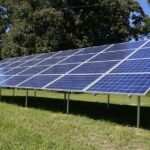
As more homeowners seek sustainable energy solutions, the demand for off-grid solar systems is on the rise.
An off-grid solar system allows you to produce and use your electricity, reducing reliance on utility companies and providing energy independence. However, choosing the right off-grid solar system for your home can be challenging.
This article will guide you through the essential factors to consider, helping you make an informed decision.
Understanding Off-Grid Solar Systems
Before getting into the details of selecting an off-grid solar system, it’s essential to grasp what it involves. An off-grid solar system is a setup that enables you to generate and store electricity using solar panels without connecting to the traditional power grid. These systems typically consist of:
- Solar Panels
- Charge Controller
- Batteries
- Inverter
Assessing Your Energy Needs
The first step in choosing the right off-grid solar system is assessing your energy needs. Here’s how to do it:
Calculate Your Energy Consumption
Begin by examining your utility bills to get a clear picture of your monthly energy usage. List all the appliances and devices you use, along with their wattage and average daily usage. To get a better idea of your needs, consider the following:
- Lighting
- Appliances
- Electronics
Create a Daily Energy Use Profile
Once you have the wattage and usage of each device, create a daily energy use profile. Add up the total watt-hours (Wh) for all devices to get your daily energy needs. This figure will help you determine the size of the solar system you need.
Choosing the Right Solar Panel Size
Once you know your daily energy needs, you can choose the right size for your solar panel system. Here are some steps to guide you:
Determine Your Solar Panel Output
The output of solar panels is measured in watts. Most residential solar panels produce between 250 to 400 watts each. Average sunlight hours vary by location, so check your local solar irradiation data.
Factor in System Losses
It’s essential to account for system losses, which typically range from 10% to 20% due to inefficiencies in wiring, inverters, and battery storage. To ensure you generate enough power, increase your daily energy use by this percentage before calculating the number of panels needed.
Selecting the Right Battery Storage
Batteries are a crucial component of your off-grid solar system as they store energy for use when sunlight is not available. Here are key considerations for choosing the right battery:
Battery Types
There are several types of batteries available:
Lead-Acid Batteries
Traditional and more affordable, but require regular maintenance and have a shorter lifespan.
Lithium-Ion Batteries
More efficient and longer-lasting, but they come at a higher upfront cost. They also require less maintenance.
Battery Capacity
Battery capacity is measured in amp-hours (Ah). To determine how much storage you need, consider the following:
- Calculate your daily energy needs.
- Determine how many days of autonomy you want
Choosing the Right Inverter
The inverter is responsible for converting the DC power from your solar panels and batteries into AC power that your home appliances can use. Here’s what to consider when selecting an inverter:
Inverter Size
To determine the size of the inverter, consider the following:
Total Wattage of All Appliances
Calculate the combined wattage of all devices you plan to run simultaneously.
Surge Power
Some appliances, like refrigerators and air conditioners, require more power to start up than to run. Ensure your inverter can handle these surge requirements.
Inverter Type
There are two main types of inverters:
- Pure Sine Wave Inverters
- Modified Sine Wave Inverters
Understanding Installation Options
Deciding how you want to install your off-grid solar system is another critical step. You can choose between DIY installation or hiring a professional.
DIY Installation
If you have experience with electrical systems and feel comfortable tackling the installation yourself, a DIY approach can save you money. Many resources, including online guides and videos, can help you through the process.
Hiring a Professional
If you’re unsure about your skills or want to ensure optimal performance, hiring a professional installer may be the best choice. Professionals can ensure that the system is set up correctly and safely, maximizing efficiency.
Budgeting for Your Off-Grid Solar System
Budgeting is essential when planning your off-grid solar system. Here are some expenses to consider:
Solar Panels
The cost of solar panels varies depending on the number and type, such as monocrystalline or polycrystalline, each with different efficiencies and prices.
Batteries
Lithium-ion batteries are generally more expensive than lead-acid batteries, but their longer lifespan and efficiency may make them a more cost-effective option over time.
Inverter
Inverter prices differ based on size and type. String inverters are usually cheaper and suitable for simpler systems, while microinverters offer better optimization for more complex setups.
Mounting and Wiring
Be sure to include installation materials like mounting racks and wiring in your budget, as these can significantly affect the total cost of your solar panel project.
Long-Term Savings
While the upfront costs can be significant, an off-grid solar system can save you money in the long run. You’ll reduce or eliminate your electricity bills, and some systems may even allow you to sell excess power back to the grid, depending on local regulations.
Remember to browse around here for additional resources and tools that can help you in your journey toward sustainable energy.
Maintenance and Monitoring
Once your off-grid solar system is installed, regular maintenance is crucial to ensure it operates efficiently. Here are some tips:
Regular Inspections
Check your solar panels for dirt, debris, or shading that may affect performance. Clean them as needed.
Monitor Battery Health
If you’re using lead-acid batteries, check the water levels regularly and maintain them according to the manufacturer’s guidelines. Lithium-ion batteries typically require less maintenance.
Use Monitoring Tools
Invest in a monitoring system that allows you to track your energy production and consumption. This will help you identify any issues early on.
Making the Right Choice for Your Home
Choosing the right off-grid solar system for your home is an investment in energy independence and sustainability. With careful planning and consideration, you can enjoy the benefits of off-grid living while reducing your environmental impact. Embrace the opportunity to harness the sun’s power and enjoy a greener, more self-sufficient lifestyle!
Got questions? We’ve got answers! Check out our blog for loads of interesting and helpful content today!





